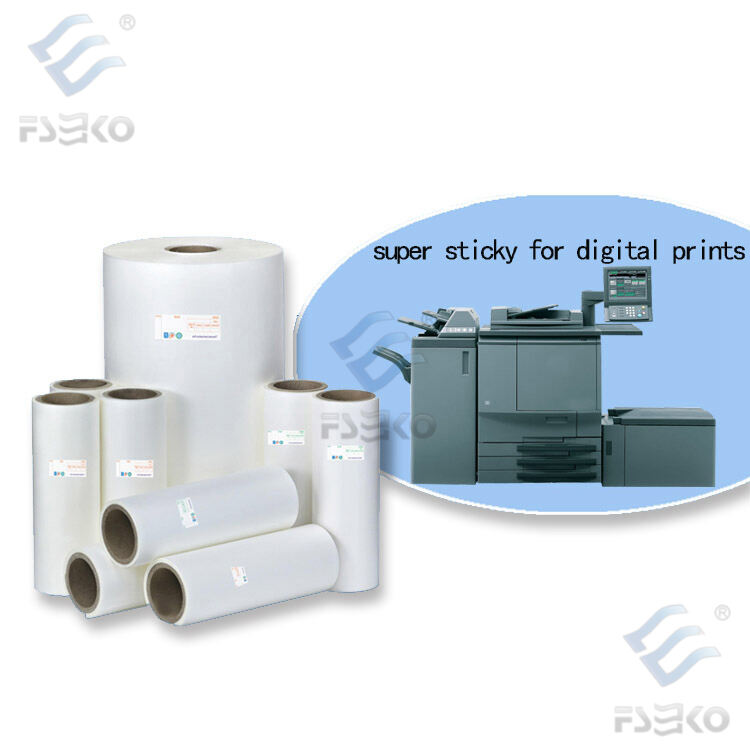Understanding Digital Thermal Lamination in Modern Printing
Digital thermal lamination is a process that elevates the quality and durability of printed materials by applying a protective lamination film. This technology leverages the power of heat and pressure to bond a thin layer of film onto surfaces, such as paper or cardstock, thereby enhancing their appearance and extending their lifespan. Its significance in modern printing is underscored by its ability to improve the aesthetic appeal of printed products through glossy finishes and vibrant colors.
The versatility of digital thermal lamination allows it to be applied across various industries like publishing, packaging, and marketing. For instance, in publishing, it ensures the long-lasting quality of book covers; in packaging, it adds a layer of protection to product boxes; and in marketing, it enhances the appeal of promotional materials. These applications demonstrate the widespread utility of lamination film for protection in different sectors.
The technology behind thermal lamination involves sophisticated machinery that utilizes both heat and pressure to activate the adhesives within the film. This creates a seamless bond between the film and the printed surface. A study published in the Journal of Printing Science highlights that the use of lamination film has increased significantly due to its effectiveness in preserving printed works against wear and tear. Additionally, expert opinions suggest that the adoption rate of digital thermal lamination in the printing sector is poised to grow at a compound annual rate of 5.5% from 2024 to 2028, reflective of its rising importance in the industry.
Incorporating digital thermal lamination into modern printing processes offers distinct advantages, including enhanced product longevity, visual appeal, and resistance to environmental factors. As the demand for high-quality printed materials continues to rise, understanding these benefits is crucial for businesses looking to optimize their printing workflows.
Types of Digital Thermal Lamination Film
BOPP Thermal Lamination Film
BOPP, which stands for Biaxially Oriented Polypropylene, is a popular choice for thermal lamination due to its durability and clarity. This type of lamination film provides excellent protection and enhances the visual appeal of printed materials, making them ideal for high-end packaging and presentation folders. The film's ability to resist water and chemical damage contributes significantly to its popularity in various industries. Statistics indicate a steady increase in the use of BOPP thermal lamination films, especially in the packaging sector, where demand for high-quality, durable films is essential.
Inkjet Printing-Specific Films
Inkjet printing-specific films are meticulously designed to heighten print quality by offering a smooth surface that effectively absorbs ink. These films are engineered for compatibility with a wide array of inkjet printers and inks, ensuring optimal color vibrancy and print fidelity. Experts highlight the performance of these specialized films, noting that they surpass standard films in delivering sharper, more vivid images. Their adaptability with various printing technologies offers businesses a versatile solution to meet diverse printing needs.
Eco-Friendly Non-Plastic Options
In response to growing environmental concerns, the industry is now leaning towards eco-friendly lamination options made from biodegradable or recycled materials. These films are designed to reduce the environmental footprint without compromising the quality of lamination. Market trends clearly show a shift towards sustainable products, driven by consumer demand for green solutions. Statistics reveal an increase in the adoption of eco-friendly lamination films, reflecting an industry-wide shift towards sustainability and responsible manufacturing practices.
Key Advantages of Using Thermal Lamination Film
Enhanced Print Durability
Thermal lamination film plays a crucial role in enhancing the print durability of materials, significantly extending their lifespan. This protective layer ensures that printed items remain resilient against wear and tear, including scratches and environmental damage. For instance, the abrasion resistance provided by these films is noteworthy, as they form a shield against physical harm, thus supporting the longevity of printed products. Studies show that materials laminated with thermal films exhibit prolonged durability under various conditions, offering considerable value to both businesses and consumers.
Professional Finish for Luxury Packaging
Thermal lamination is pivotal in elevating the aesthetic appeal of luxury packaging. This process adds a professional finish that enhances the visual allure of packaging materials, making them more attractive to consumers. Aesthetics play a significant role in branding and consumer perception; well-laminated packages are perceived as high-end and premium. Luxury brands, such as those in cosmetics and high-end electronics, use lamination to enhance their product's appeal, associating their brand with quality and exclusivity. This finishing technique not only improves the visual appearance but also enhances consumer attraction to the product.
Moisture and Scratch Resistance
One significant advantage of using lamination film is its ability to protect printed materials from moisture and scratches. Moisture can severely damage printed paper, leading to smudging and degradation over time, but lamination acts as a barrier that prevents water infiltration. Furthermore, the scratch-resistant properties of lamination contribute to preserving the clarity and integrity of printed items, even with frequent handling. Industry reports highlight the effectiveness of lamination in safeguarding prints, ensuring that they remain vibrant and intact over extended periods. This protection is essential for maintaining the quality and professional appearance of printed materials.
Overall, understanding these advantages underscores the importance of selecting the appropriate type of lamination film for different applications, ensuring both enhanced protection and improved presentation.
How to Apply Lamination Film Effectively
Step-by-Step Application Process
Applying thermal lamination film correctly is crucial for achieving a smooth finish without bubbles. Here’s a step-by-step guide to ensure effective application:
- Prepare the Surface: Ensure the print material is clean and free from dust or moisture.
- Select the Right Film: Choose a lamination film that suits the type of print and end-use requirements.
- Heat the Laminator: Set the laminator to the recommended temperature for your chosen film. This typically ranges from 90°C to 130°C, depending on the film type.
- Position the Film: Align the film on the material ensuring an even margin on all sides.
- Feed Into Laminator: Slowly feed the aligned materials into the laminator, ensuring consistent pressure is applied.
By following these steps meticulously, you can achieve optimal adhesion and minimize issues like bubbling, enhancing the overall quality of your laminated prints.
Temperature and Pressure Guidelines
Correct temperature and pressure settings are pivotal for the success of thermal lamination. It's essential to adjust the laminator based on the material being laminated and the specific film type. For instance, standard BOPP lamination films typically require a temperature of 95-110°C and moderate pressure. However, films intended for thicker materials or those with different thermal properties may demand adjustments. According to lamination experts, higher temperatures combined with excessive pressure can lead to overheating, which increases the risk of bubbling and wrinkling. Therefore, fine-tuning these parameters is key to consistent lamination quality. Follow manufacturer guidelines closely to optimize settings for the best results.
Troubleshooting Common Issues
Lamination can sometimes present challenges such as curling, bubbling, or uneven adhesion. A common issue involves materials that curl post-lamination, often due to incorrect temperature settings or incompatible materials. To address bubbling, reducing the laminator’s speed or temperature might help. Additionally, if edges begin to lift, increasing the pressure slightly can ensure better adhesion. Referring to comprehensive guides or expert suggestions can often provide solutions to these common problems. Being aware of these potential issues and knowing corrective measures can greatly enhance the effectiveness and longevity of laminated products. If persistent issues occur, consider consulting with laminator manufacturers or repair technicians for more tailored solutions.
Protective Qualities of Lamination Film
UV Resistance for Longevity
UV resistance plays a crucial role in extending the life of printed materials. By blocking harmful ultraviolet rays, lamination film helps preserve the integrity and appearance of prints, reducing fading and degradation over time. Certain lamination films are specifically designed to offer UV protection, thus enhancing the durability of various products. Studies demonstrate that materials protected from UV exposure maintain their quality significantly longer than those without such protection, making lamination an essential process for those seeking longevity in printed items.
Chemical Protection in Harsh Environments
Lamination films are vital for safeguarding printed products in environments exposed to harsh chemicals. These films create a barrier that prevents chemical substances from penetrating and damaging the print, thus preserving its appearance and function. There are specific films available, such as chemical-resistant lamination films, designed for this purpose. Real-world applications include use in industrial settings and laboratories where protective quality is crucial for the longevity and integrity of signs and labels. This type of film ensures that even in challenging environments, prints retain their quality, serving their intended purpose without compromise.
Maintaining Color Vibrancy
Thermal lamination is instrumental in preserving the vibrancy and color fidelity of printed materials. It combats fading and wear by providing a protective seal over the print surface, which prevents color degradation. Products without lamination are prone to losing their vividness quickly due to exposure to environmental factors. Expert opinions staunchly advocate for lamination as a method for maintaining color quality in prints, emphasizing its effectiveness in keeping prints lively and attractive over extended periods. Therefore, utilizing lamination ensures that your prints retain their aesthetic appeal despite prolonged exposure.
Future Trends in Digital Lamination Technology
Sustainable Material Innovations
As the world shifts toward greener solutions, sustainable material innovations in digital lamination technology are gaining traction. Emerging trends focus on developing eco-friendly lamination materials, such as bio-based and recyclable films, to reduce environmental impact. According to a recent industry report, the adoption of sustainable practices within the lamination sector is expected to grow by 7% annually over the next five years. These innovations are driven by consumer demand for environmentally responsible products and stringent governmental regulations.
Smart Packaging Integration
Smart packaging represents a groundbreaking advancement in the lamination industry, coupling technology with traditional packaging methods. This trend involves integrating smart features like RFID tags or QR codes that can provide additional product information or track inventory. The application of smart lamination films in sectors like pharmaceuticals and food can enhance safety and customer interaction. Innovative companies are at the forefront of this technology, aiming to revolutionize packaging by merging digital capabilities with lamination solutions.
High-Speed Application Systems
Advancements in high-speed application systems are set to redefine efficiency in digital lamination processes. These systems, designed to handle high volumes in commercial printing operations, significantly reduce turnaround times and operational costs. The benefits extend to increased productivity, allowing businesses to meet tight deadlines while maintaining quality. As these systems become more refined, they promise to optimize printing workflows, enabling companies to enhance competitiveness in a fast-paced market.


